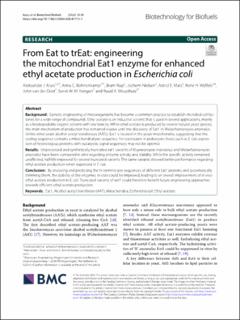| dc.contributor.author | Kruis, Aleksander J. | |
| dc.contributor.author | Bohnenkamp, Anna C. | |
| dc.contributor.author | Nap, Bram | |
| dc.contributor.author | Nielsen, Jochem | |
| dc.contributor.author | Mars, Astrid E. | |
| dc.contributor.author | Wijffels, Rene Hubertus | |
| dc.contributor.author | van der Oost, John | |
| dc.contributor.author | Kengen, Servé W. M. | |
| dc.contributor.author | Weusthuis, Ruud A. | |
| dc.date.accessioned | 2021-02-24T13:24:23Z | |
| dc.date.available | 2021-02-24T13:24:23Z | |
| dc.date.created | 2021-02-15T14:03:10Z | |
| dc.date.issued | 2020 | |
| dc.identifier.citation | Kruis, A. J., Bohnenkamp, A. C., Nap, B., Nielsen, J., Mars, A. E., Wijffels, R. H., van der Oost, J., Kengen, S. W. M. & Weusthuis, R. A. (2020). From Eat to trEat: engineering the mitochondrial Eat1 enzyme for enhanced ethyl acetate production in Escherichia coli. Biotechnology for Biofuels, 13: 76. doi: | en_US |
| dc.identifier.issn | 1754-6834 | |
| dc.identifier.uri | https://hdl.handle.net/11250/2730150 | |
| dc.description.abstract | Genetic engineering of microorganisms has become a common practice to establish microbial cell factories for a wide range of compounds. Ethyl acetate is an industrial solvent that is used in several applications, mainly as a biodegradable organic solvent with low toxicity. While ethyl acetate is produced by several natural yeast species, the main mechanism of production has remained elusive until the discovery of Eat1 in Wickerhamomyces anomalus. Unlike other yeast alcohol acetyl transferases (AATs), Eat1 is located in the yeast mitochondria, suggesting that the coding sequence contains a mitochondrial pre-sequence. For expression in prokaryotic hosts such as E. coli, expression of heterologous proteins with eukaryotic signal sequences may not be optimal. Results Unprocessed and synthetically truncated eat1 variants of Kluyveromyces marxianus and Wickerhamomyces anomalus have been compared in vitro regarding enzyme activity and stability. While the specific activity remained unaffected, half-life improved for several truncated variants. The same variants showed better performance regarding ethyl acetate production when expressed in E. coli. Conclusion By analysing and predicting the N-terminal pre-sequences of different Eat1 proteins and systematically trimming them, the stability of the enzymes in vitro could be improved, leading to an overall improvement of in vivo ethyl acetate production in E. coli. Truncated variants of eat1 could therefore benefit future engineering approaches towards efficient ethyl acetate production. | en_US |
| dc.language.iso | eng | en_US |
| dc.publisher | BioMed Central | en_US |
| dc.rights | Navngivelse 4.0 Internasjonal | * |
| dc.rights.uri | http://creativecommons.org/licenses/by/4.0/deed.no | * |
| dc.title | From Eat to trEat : engineering the mitochondrial Eat1 enzyme for enhanced ethyl acetate production in Escherichia coli | en_US |
| dc.type | Peer reviewed | en_US |
| dc.type | Journal article | en_US |
| dc.description.version | publishedVersion | en_US |
| dc.rights.holder | © 2020 The Author(s) | en_US |
| dc.subject.nsi | VDP::Teknologi: 500::Bioteknologi: 590 | en_US |
| dc.subject.nsi | VDP::Matematikk og Naturvitenskap: 400::Basale biofag: 470::Biokjemi: 476 | en_US |
| dc.subject.nsi | VDP::Matematikk og Naturvitenskap: 400::Basale biofag: 470::Molekylærbiologi: 473 | en_US |
| dc.subject.nsi | VDP::Matematikk og Naturvitenskap: 400::Basale biofag: 470::Generell mikrobiologi: 472 | en_US |
| dc.source.pagenumber | 10 | en_US |
| dc.source.volume | 13 | en_US |
| dc.source.journal | Biotechnology for Biofuels | en_US |
| dc.identifier.doi | 10.1186/s13068-020-01711-1 | |
| dc.identifier.cristin | 1889950 | |
| dc.source.articlenumber | 76 | en_US |

